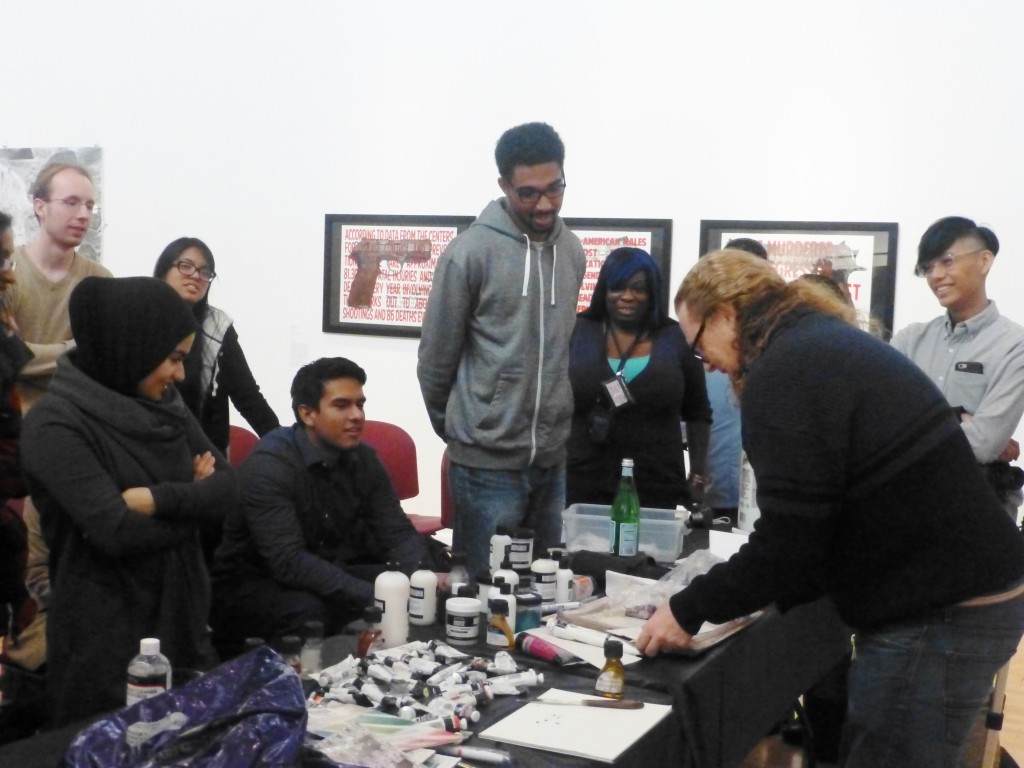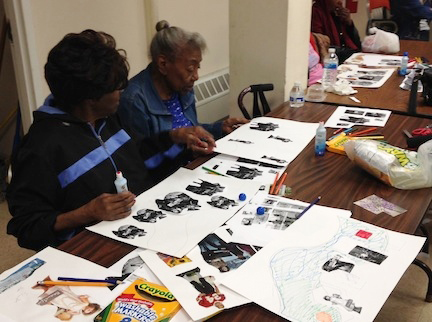New in Newark: Paul Robeson Galleries Offer New Exhibits, Art Spaces and Collaborations

Fun fact: There are more than 900 roads and highways across the United States named for Dr. Martin Luther King, Jr. (I know this is for real--I read it on the interwebs).
And there is nothing odd about this. Dr. King was a great man who played an integral role in our history. What does seem odd, though, is the lack of an apparent connection between Dr. King and his work and these hundreds of American roadways. I also believe that the act of designating a namesake becomes less and less meaningful as our culture moves at downhill-slope-speed toward the practice of tagging with a name nearly everything that is part of daily life.
Of course, there are exceptions. And a notable one is Rutgers University-Newark’s (RU-N) Paul Robeson Galleries, a network of exhibition spaces that showcase the work of emerging and established contemporary artists.
Let’s talk for a moment about Paul Robeson. He attended Rutgers University – one of just three African Americans to do so at the time – on a four-year scholarship. He was an excellent athlete, an outstanding student, a member of the debate team and class valedictorian.

Art Break program occurring in the lobby of Express Newark, in the Hahnes Building. The workshop is being led by artist Kati Vilim and participants are working on large versions of paintings inspired by her work. Vilim is the first Artist in Residence for Paul Robeson Galleries.
Following college, he got his law degree from Columbia. He practiced for a short time and then left the legal field to return to his childhood love of acting and singing. Robeson traveled widely as a professional performer, and saw first-hand how difficult life was for many people throughout the world. This exposure to human struggle opened his eyes and compelled Robeson to become a more vocal supporter of human rights and freedom.
Anonda Bell, Director and Chief Curator of the PRG, explained further: “Robeson was forthright. He was not one to sit quietly on the sidelines. He spoke up, and he spoke out loud.”
In 1972, RU-N created a campus center, and part of the design included gallery space. The decision to name the gallery for Robeson grew organically, from a combination of student activism, the acknowledgement of inequality at the university and Robeson’s own strong sense of justice and equality. Creating a space that is democratic and open to everyone and naming it for Robeson seemed a fitting way to honor the ideals and philosophy that Robeson represented.
“The fact is,” Bell said, “he was not just active in the arts, Robeson was also an activist.”

A public program demonstration of painting materials led by Winsor and Newton representative in the Robeson Campus Center Gallery.
According to the PRG website, their mission and programming is meant to “embody Paul Robeson’s life-long commitment to unfettered artistic freedom, cultural democracy and transnationalism.”
Wow. Just wow.
Now, fast forward to 2017. The Paul Robeson Galleries have expanded. There are now multiple spaces in three locations. The newest is Express Newark, housed on two floors of the former Hahne & Co. department store. Conceived by RU-N faculty, staff, students and community arts leaders, Express Newark is part of a larger plan to encourage creativity and artistic expression through interaction between the Newark community and the university.
“The physical building is strategically located,” Bell said, “on the periphery of the traditional campus, in the downtown area. It creates a non-academic space, apart from the ‘ivory tower’ of the university, but still part of the greater community.”
In addition to its three exhibition spaces, the building provides an opportunity for organizations and members of the public to have access to services such as a design consortium, 3-D printing studio, a photographic portrait studio, video production teaching facilities, smart classrooms, seminar rooms and more.
“There will be also be public and education programs, both on-site and offsite,” Bell said, “that will serve all ages and a wide range of people.”
The first exhibition, installed at the Large Gallery, is “Records at Play: The Institute of Jazz Studies @50.” The show is a collaboration with The Institute of Jazz Studies, which has been collecting jazz records at RU-N for 50 years. And it marks the first time the Institute has shown such a large portion of its collection. The exhibition includes not only sound recordings, but also paper and music-based archives, instruments, textiles, machine on which music was played and more.
“It was a conscious choice to do this as the first show at Express Newark.” Bell said. “We thought this would be a good way to work out the boundaries between different art forms.”
While this is the largest current exhibition now, there are several other shows happening as well.
“Women of the World,” presented in conjunction with Women in Media’s 8th Annual Women’s History Month Film Festival and featuring the work of nine women artists, is showing through March 29 at the Robeson Campus Center Gallery.

A performance in The Window gallery featuring artist David Antonio Cruz and singer Janetza Maria Miranda. The performance was arranged by curator Kevin Darmanie who organized the exhibition “Our Anxious Times”.
“Portrait Garden,” by artist Lynn Cazabon, runs through July 31 at the School of Criminal Justice Gallery. Through the garden project, individual interviews and photographs of the cultivated plants, this unique exhibition documents the creation of three perennial gardens on the prison grounds by 11 women inmates. A reception will be held on Monday, March 20.
Also on view through July 31 is “Indivisible,” a mural by the Harlem-based artist and 2014 Rutgers graduate Vaughn Spann, in Engelhard Hall, 1st floor, and “Beneath Such Dreamy Moments,” a site-specific installation by Joan Pamboukes inspired by Newark Museum’s historic Ballantine House, on view at The Wall, Robeson Campus Center, 1st floor. Pamboukes' piece is part of the RU-N Seed Grant Galleries initiative.
Two additional gallery spaces are part of the PRG – the Window Gallery and The Box at Hahne’s/Express Newark. I told Bell that I especially like the idea of using storefront windows as gallery space and she agreed. “It’s another way to reach out,” she said, “and it makes the work more accessible.”
Bell summed it up this way, “We are aiming to have art all over the place.”
Exhibitions at the Rutgers University-Newark’s Paul Robeson Galleries are free and open to the public. For hours and information about the Paul Robeson Galleries, click here .

